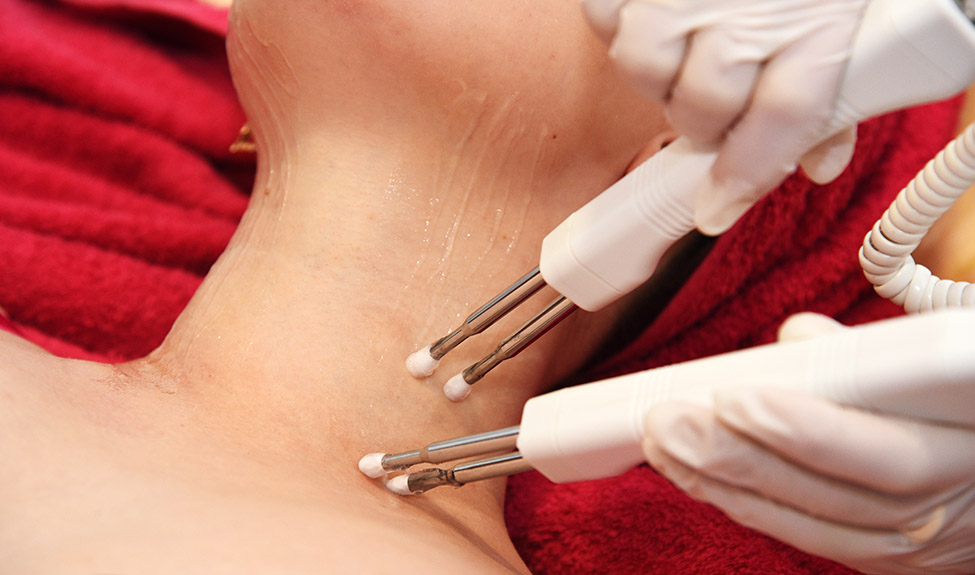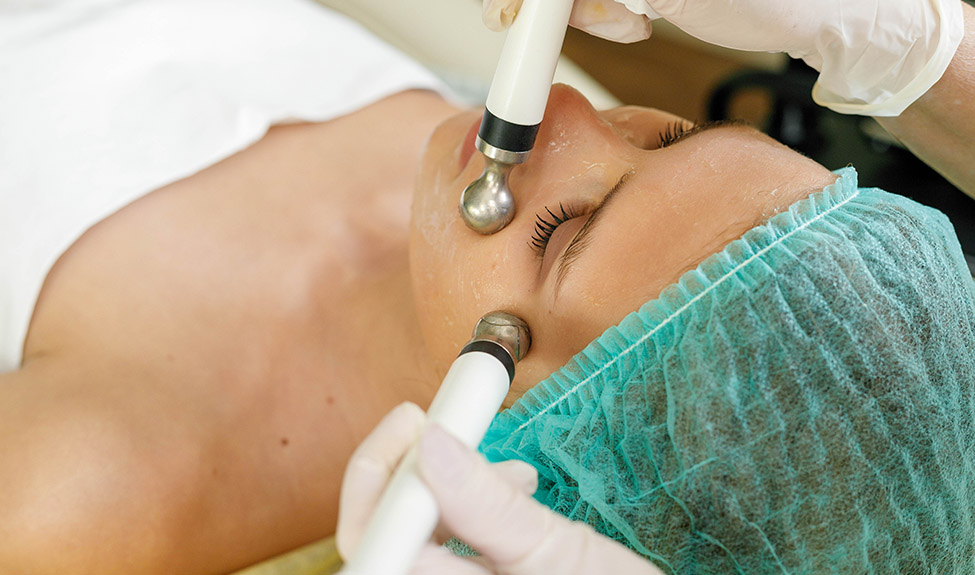Aging is an inevitability and one of the most common skin concerns for spa clients. There’s no replacement for a daily skincare routine, but professional facial treatments can contribute to a strong foundation on which to build.
Some clients are likely to assume that, in order to achieve visible and lasting results with an anti-aging treatment, they have to sit through a long and possibly painful session. That’s where microcurrent facials come in.
The microcurrent facial is nothing new. It was originally developed in the 1980s as an FDA-approved treatment for Bell’s palsy, but it has recently gained attention as an elective skincare treatment.
As a licensed esthetician, your client’s skin is literally in your hands. Before recommending or administering microcurrent facials, take the time to learn what they are, what benefits they provide, and how to safely and effectively administer them.
What is a Microcurrent Facial?
The idea of electric currents running through the skin may be scary to some clients, so it’s important to provide education about this new treatment option and quell any preconceived fears they may have. A microcurrent facial does involve electric currents, but it’s non-invasive and completely pain-free.
This treatment involves the use of special tools that emit low-intensity electrical currents. The currents stimulate the skin and facial muscles to tone, lift, and reactivate them. The client will feel a light “pulsing” on their skin. It’s sometimes referred to as a workout for the face, though microcurrent facials have also been described as natural, non-invasive facelifts.
A microcurrent facial typically includes the staples of any spa facial – cleansing, exfoliation, facial massage, and hydration – with the addition of those micro-currents, of course. These treatments generally last between 45 and 90 minutes, depending on what additional services are included.
What Are the Benefits?
Microcurrent facials are, in essence, facial sculpting treatments. They’re primarily marketed as anti-aging treatments designed to firm and tone the face. Much like a facelift, a microcurrent facial can help define the cheekbones and jawline while reducing the appearance of fine lines and wrinkles.
Here are a few potential benefits associated with microcurrent facials:
- Reduce appearance of fine lines and wrinkles
- Renewed and revitalized skin
- Lifted eyebrows and jawline
- Enhanced penetration of skincare products
- Improved blood flow
- Reduced appearance of hyperpigmentation
- Improved lymph drainage
But how exactly does a microcurrent facial deliver these results?
The purpose of a microcurrent facial is to stimulate the muscles under the skin. This differs from most other skincare treatments, which focus on promoting a healthy, toned, and smooth epidermis. The muscles and fascia under the skin provide support and help define the shape of the face. Electrical stimulation helps lift and tone these muscles to give the face a more sculpted look. Regular treatments may, in effect, train the facial muscles to stay in shape – this is known as muscle re-education.
Who Is a Microcurrent Facial Right For?

One of the factors that makes microcurrent facials so popular is that they are safe for all skin types and ages. What’s more, this treatment is non-invasive, so it shouldn’t bother sensitive skin as long as any gels or oils used to reduce friction are non-irritating. Some patients may experience redness after the treatment, but there is no downtime otherwise.
Microcurrent facials are ideal for clients who want to see immediate results. While the results of a single session may be subtle, clients are likely to notice decreased puffiness and improved definition – especially around the cheekbones and eye contours.
While microcurrent facials are marketed as an anti-aging treatment, many experts disagree on what the ideal client looks like. Some suggest that the muscle contraction stimulated by single microcurrent treatments isn’t enough to strengthen the muscle long-term but rather plump it in the short-term. Skincare experts in this camp often suggest that the treatment may produce the most noticeable results for clients in their 20s and 30s whose skin hasn’t yet lost elasticity and tone.
One important factor to mention to your clients is that microcurrent facials work best with repeated treatment. Clients should plan to make monthly appointments if they hope to see long-term results.
Tips for Administering a Microcurrent Facial
Microcurrent facials are generally regarded as safe but, as a skincare professional, it’s your duty to inform clients of any potential risks. Clients with heart conditions that may be affected by electrical currents may want to avoid this treatment. Individuals who have received dermal fillers should wait at least two weeks before undergoing microcurrent therapy.
Here are a few additional things to keep in mind when recommending or administering a microcurrent facial:
- Any facial treatment begins with a deep cleanse – removing makeup, surface oil, and impurities is essential to ensure proper penetration of the microcurrents.
- Gently exfoliate the client’s skin using a product appropriate for their skin type – exfoliation removes dead skin cells to help prep the skin to absorb the microcurrent.
- Choose the right conducting gel – this gel carries the microcurrent into the muscle (it’s also known as an activator).
- When administering, glide the wand gently over the neck, cheeks, and forehead, completing one side of the face before doing the other – be sure to show your client the results for comparison.
- Finish the treatment with the appropriate serums, moisturizers, and other products for your client’s skin type and skin concerns.
- Always apply SPF as the final step in any facial treatment. Microcurrent facial won’t increase the client’s sensitivity to sunlight, but sun protection is a must.
- Advise your client to avoid using retinol prior to their next microcurrent treatment – the current can push retinol deeper into the skin, causing redness or puffiness the day after treatment.
Microcurrent facials are a popular trend in skincare but they’re not the right choice for every client. As a skincare professional, it’s your job to ascertain the client’s skin concerns and recommend a treatment.
To see results, clients should plan to receive regular microcurrent facials – about once per week for the first few months followed by monthly maintenance sessions. If this isn’t practical or economical for your client, you might recommend another treatment with anti-aging benefits like intense pulsed light therapy or vitamin C facials.

